Bittersweet memories

Late summer is a magical time in the beekeeping year.
There's still lots to do before winter, but there's a lot less to do than there was a month or two ago.
You can take a bit more time over things, and still get everything finished.
So … relax 😄.
The harvest is in full swing. Everything seems ahead of last year, a consequence of the long, warm spring, and the dry summer. The oil seed rape was cut a month before the 2024 date, and the combines have dustily trundled through the golden fields of wheat, leaving tight-packed bales of straw scattered everywhere. As the sun sets — appreciably earlier now than just a few weeks ago — they cast long, angular, shadows over the stubble.
It's about this time of the season that the results of your hard graft in late-April, May and June — the swarm control, queen rearing, and mite monitoring — become apparent. If things have gone well you'll have boxes bursting with healthy bees, and topped with supers full of capped honey.
Now all you need to do is keep the bees you want, unite those you don't, massacre as many mites as possible in as short a time as practical, and feed the bees up for winter.
All this was covered in a recent post, so I'm not going to repeat myself.
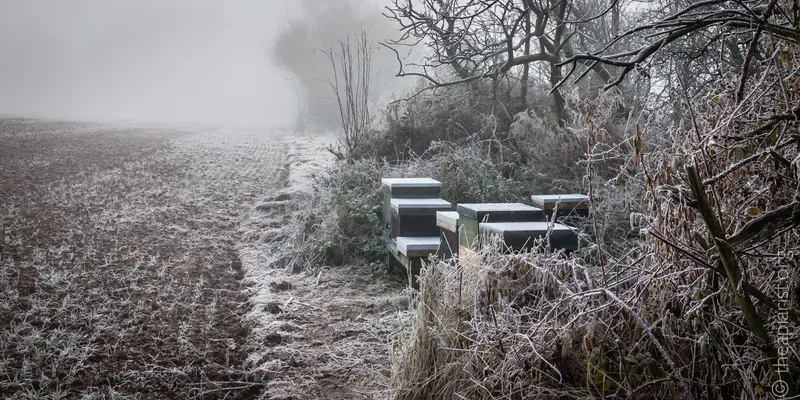
As I said earlier … there's still lots to do and, arguably, these are the most important tasks of the entire season.
Done poorly, done late, or not done at all, and you're already jeopardising next season.
Stop, look, listen
With swarming long-finished, the routine 7 or 10 day inspection rotation has been abandoned. There's little point in looking for something (queen cells) that won't be there. Instead, the time is used making decisions about what to overwinter, and what to unite, and in trying to find, clip and mark the last of the new queens.
But in between those things, it's worth taking time to watch the season winding down around you.
The swifts have gone already. The swallows and house martins congregate in gossiping groups on the telegraph wires in the mornings, then spend the day hawking insects over the stubble or recently ploughed fields. But there are fewer every day. It won't be long until there are only passing singletons. Do the birds I see flying south in October ever make it to Namibia or Botswana, or do they perish on their 6,000-mile migration?
The woods and copses are filled with the plaintive mewing of young buzzards. They're still partially dependent upon the parental birds for support, but will soon be unceremoniously turfed out of the territories to fend for themselves.
And, as well as doing all that stopping, looking and listening, remember to pick some blackberries. There's a glut at the moment and the freezer won't fill itself. As with the arable harvest, everything feels a bit ahead of itself this year.
Why not become a sponsor?
Sponsors receive weekly posts on bees and beekeeping, at least 50% of which are for sponsors only. Sponsorship costs less than a coffee and a slice of flapjack a month … or less for an annual membership.
The new, old apiary
My new, old apiary — the Lost City of Z — is taking shape.
In comparison to many parts of the Scottish Borders, it's very sheltered, occupying a shallow crease in the land, and protected on all sides by mature trees.
In fact, it's so sheltered, that working there during the warmer days this summer has been stiflingly hot and uncomfortable. Nevertheless, I've made reasonable progress, putting in hive stands and some pallets for spare equipment.
It's taken longer than I'd hoped, largely because the ground sloped more than I'd first thought … though, in fairness, the ground was invisible under waist high weeds when I reconnoitred the site.
Having cleared the weeds it was a case of “I've started, so I'll finish” {{1}}, so I cut wedges out to create platforms for paving slabs, installed and levelled the hive stands and — eventually — moved some nucs in.
The soil is rich, and the weeds are already trying to swamp everything again; I've laid matting in front (and underneath) the hive stands to try to suppress them. It looks ugly at the moment, but the edges will soon soften.
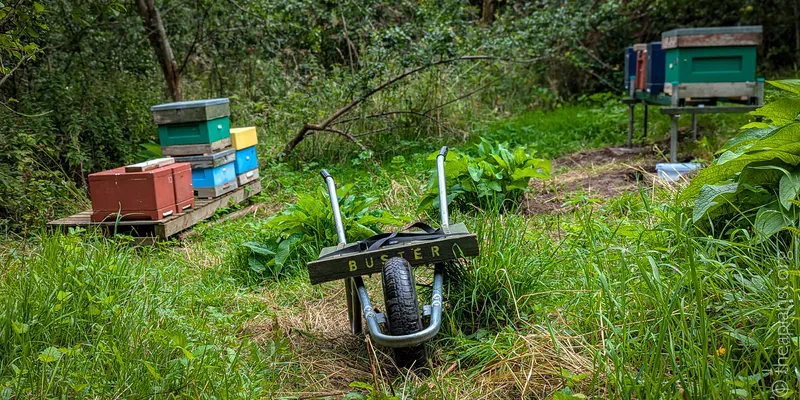
On typically windy days, when bees are struggling to return to the hive in other apiaries, here they fly in over the trees, descending in a column of calm air, and alight directly without being buffeted about. Will it make any difference to colony strength or the honey harvest? Probably not, but there will be fewer crash landings, and it will make inspections much easier.
The trees in the orchard are heavy with fruit — apples, pears, plums, damsons — so I'm on the alert for a late-season surge in wasp numbers. They've been less trouble here than in my other apiaries this summer, but there's still time for problems to occur. The WaspOff™️ entrances can be put back if needed for the last few weeks of the season.
In the meantime, the hydropress will shortly be recovered from storage for the heather harvest … and it's tempting to think about trying to make some cider at the same time, as that's what the hydropress is actually designed for.
Not exactly at the same time … that would be silly 😉.
Queens
I like to clip and mark newly mated queens within a month of them starting to lay. By that time the nuc she's in still remains relatively sparsely populated — so she's easy to find — but there's been sufficient time to ensure the queen is laying well.
So, throughout June and July, my hive notes regularly carry the annotation 'C&MQ' as a reminder of what to do at the next hive inspection. And, in August, if I've failed to find the queen, or she's from a later set of grafts, the annotation is highlighted and underlined.
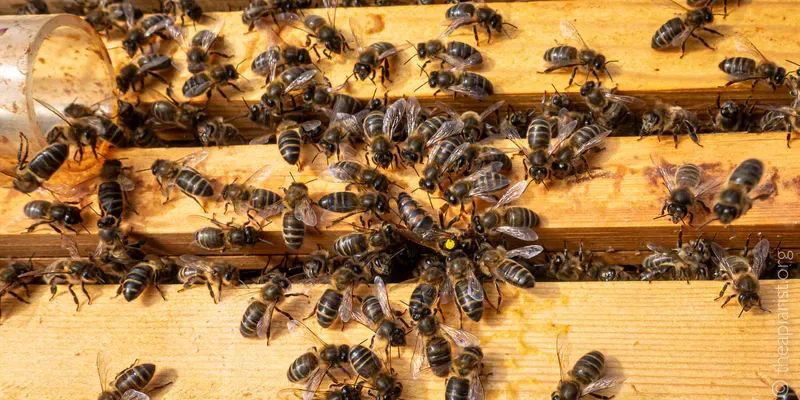
I've discussed the mechanics of queen marking recently. Since I also routinely clip one of her wings, this involves handling the queen — albeit briefly.
Inevitably, there's a small risk associated with this, probably not quantifiable, but nevertheless more than zero.
In June, or early July, the risk is almost insignificant. A lost or damaged queen mid-season is relatively easy to replace. However, it's a different matter in late August. There's no time to rear another, and it's unlikely there are any 'spares' left, so any losses will inevitably necessitate uniting the colony with another.
Oops
It was therefore frustrating to drop a queen in the long grass of the new apiary.
'Drop' doesn't quite capture the hamfistery involved.
On picking her from the frame, holding her by a wing, a worker tagged along and looked to be trying to sting the queen … curved under abdomen, angry buzzing, you get the picture. I blew gently on the pair of them, successfully dislodging the irate worker, but must have also let go of the queen at the same time.
She flew once, unsteadily, around me and then spiralled down into the grass, out of sight on the far side of the hive {{2}}.
Grrr!
After twenty minutes of searching on my hands and knees I found her and ran her back in the front entrance {{3}}.
Why bother looking? Surely she'd have found her own way back?
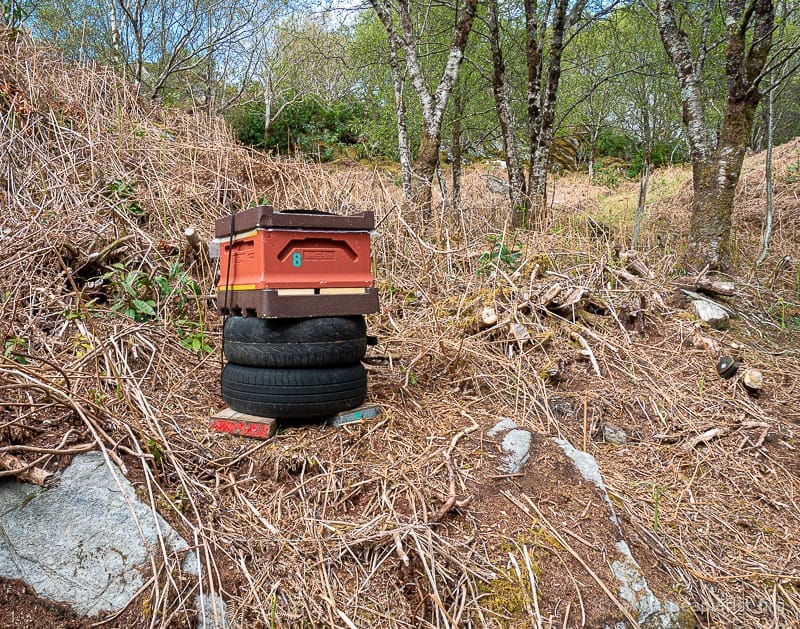
Note the question mark in the title of the post
This queen was mated in a different apiary, so had never orientated to the location she was now occupying. The nuc was one of four on my 'ultimate hive stand' {{4}}, flanked by other nucs. Had she climbed the leg of the stand she would have had to negotiate one or two other nuc entrances to find her own. The nucs all had Varroa trays inserted under their OMFs, so it was unlikely she'd have ended up underneath the floor.
Yes, she probably would have got back, but I was far from certain (and, had she failed to return, I'd have lost the nuc).
At the time I felt the best thing to do was to search for her in the herbage, and — because I found her and everything ended up OK — I'm certain it was the correct decision.
Of course, had I not found her, but instead inadvertently stomped on any chance she had of ever returning, I'd have written something else instead of the paragraphs above 😉.
This is another example of beekeeping judgement I discussed back in May. There's no right or wrong answer, just a considered decision based upon the available information.
Often made in a rush 😉.
If you want to avoid the AI 'slop' that increasingly contaminates beekeeping websites then please consider supporting The Apiarist. Sponsors ensure the continued existence of the site, and receive regular sponsor-only content. ChatGPT has never opened a hive or dropped marked a queen, so why trust its judgement when seeking information (or entertainment) on the science, art, and practice of sustainable beekeeping?
The two queen hive
The hive containing two half-sister supersedure queens back in May still contains both queens. I've seen one or other of them most weeks during the intervening period, and both together several times.
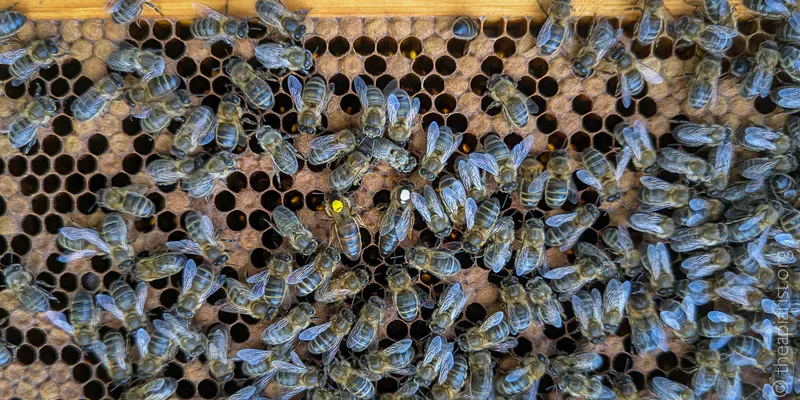
However, I'm reasonably certain only one of them is a laying queen.
I caged one queen on a frame of drawn comb for four days, and then looked inside and outside the frame for fresh eggs. There were none inside, but there were eggs outside it. There's a faint chance that the caged queen temporarily stopped laying {{5}}, but it seems unlikely. However, I can be certain that the one outside is laying.
As an experiment I've left both queens in the box to see what happens.
Failed supersedure … probably
About four weeks ago I added foil-wrapped mature queen cells to some queenright hives. This was an attempt at 'induced supersedure', where the incumbent is replaced by the new queen, without the trouble of having to find and remove the original queen. It's a method I've used successfully before, although never later than mid-season.
The introduced queens all emerged as expected and on time. I left the boxes a full fortnight before checking them again. All contained the original marked laying queen.
So does this mean that the supersedure failed?
Probably, but not definitely.
These are reasonably strong colonies with 9+ frames of brood, and topped with 2–3 supers {{6}}. Finding an unmarked queen in a busy hive is never guaranteed. Yes, you can usually achieve it with a bit of skill, a pinch of luck, or a lot of disruption.
I often lack the first two, and I wasn't prepared to apply the latter.
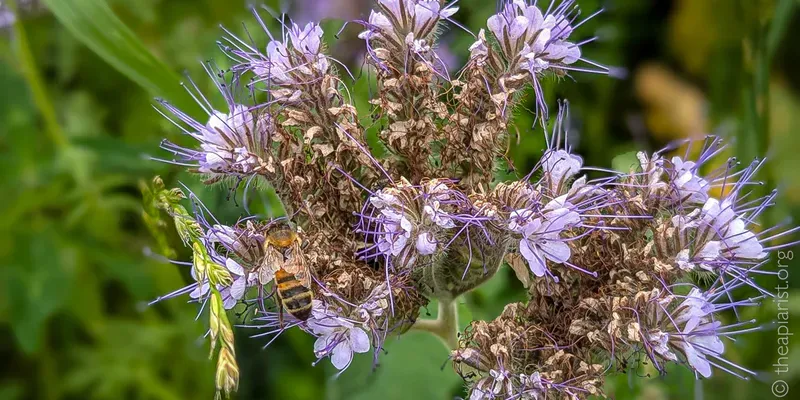
The colonies were queenright, it's late in the season, and they were busy filling the supers with Phacelia nectar. Other than the satisfaction of knowing, there was nothing to be gained by rummaging through to find a new queen that might not be there anyway.
I'll check again early next year. If the original marked queens are still there I'll conclude that late season induced supersedure doesn't work. Or, to be more accurate, didn't work this time … there are so many variables at work (age of the 'old' queen, strength of the colony, weather, nectar availability etc.) that you can never say never.
But I might not rush to try it again 😉.
Night moves
Well, not night, but late evening and early morning {{7}}.

I populated the new apiary with nucs. Some have already been promoted to full hives, but others are not yet strong enough for a 'big box'. In fact, those containing the most recently mated queens are a little less strong than I'd like, even if I was to overwinter them as nucs.
The easiest solution to this is to harvest brood and bees from strong colonies, and give them a boost. The strong colony is not obviously weakened, but the nuc gets a real 'pick me up' {{8}}.
But the apiary only contains nucs, and a couple recently expanded into hives, none of which have brood and bees to spare.
I therefore sealed the nucs up late one evening and moved them to an apiary containing strong honey production colonies. This apiary is next to a big field of late-sown flowering Phacelia. The nucs will get a nectar boost from the location alone and, with all that forage available, should be protected from robbing bees (who have a laser-like focus on the Phacelia bonanza).
How late is late?
Here in the Borders I'm moving bees about half an hour after sunset. If you're observant you'll see a trickle of late foragers returning, even when it's almost too dark to see.
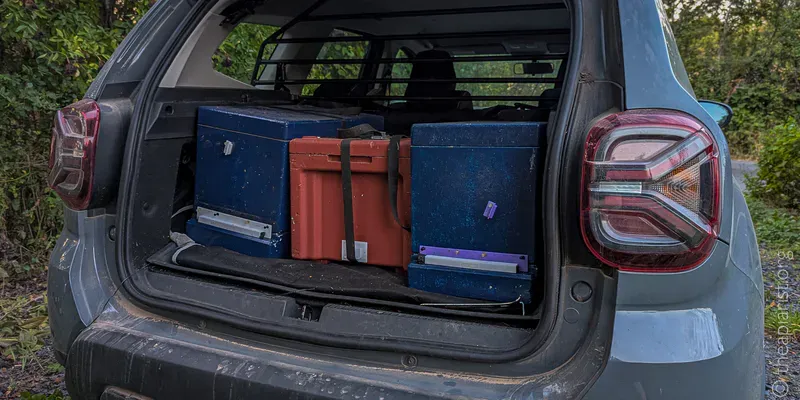
Irrespective of how long you wait for these last few stragglers to return before moving the hive, the original site will have a few bees flying around it the following morning. These are probably bees that bivouacked out overnight. However, studies have shown that foragers can (rarely) return over distances much greater than 3 miles, so they could be early risers that failed to reorientate to the new location.
I'll let the nucs settle for a few days, to be sure I don't lose bees when I open the lid. By then the Phacelia should be over the peak, so I'll steal a frame from each production colony to boost the nucs. I'll use air freshener to 'unite' the donated frame quickly and easily with the nuc, and then move the boosted nuc back to the original apiary later the same day (to avoid losing the added foragers).
Heather
At the opposite end of the day, it will soon be time to recover hives taken to the hills for the heather honey. The heather is still flowering patchily, but there's been too little rain for weeks, and it's going to be a modest harvest (at best).

Getting to the site involves negotiating a couple of miles of rough tracks, a ford, and some stunning scenery. At least, it looks good from the passenger seat. When driving you're focused on the precipitous drops beside the track, suicidal game birds, and the 'intellectually challenged' sheep.
Tackling this in the failing evening light would not be sensible; it would be idiotic.
Instead, I'll be setting off around 5 am to get there before the bees start flying, so I can seal up the hives and bring them back, without leaving half the foragers wondering where 'home' went.
Bittersweet memories
There's a poignancy about this late-season beekeeping.
One of the most rewarding things about keeping bees is that it keeps you in touch with the changes in the season. I'm fortunate to live rurally, but even when I lived on the outskirts of a large town I was much more aware of the cycles of the seasons after I started beekeeping.
But, of course, being mindful of these changes means I'm also acutely aware that those happening now — the missing migrants, the heather going over, the earlier sunsets — all mean that the season is galloping to a close.
On a calm evening (and we do have them) the apiary is a wonderful place to be. The production colonies are humming busily as the bees evaporate off the water from nectar in the supers. You can hear the hives from yards away, and the smell is sensational.
In another week or two it will be all over. Except for recovering Apivar strips from the colonies in late October, an oxalic acid application when broodless, and an occasional check for storm damage or underweight hives, there will be no more beekeeping until late-March.
Seven months is a long time away, so — while completing all the essential late-season tasks — make sure you pause to appreciate the time spent with your bees this season.
Happy memories 😄
More like this?
That's about 3,000 words you've just read on bees and beekeeping. If you want more of this every week, then why not sign up as a sponsor of The Apiarist? At least 50% of posts are now for sponsors only, and sponsors ensure that there will be comprehensive, well researched and entertaining posts on sustainable beekeeping appearing every week.
{{1}}: How topical, a 50 year old catchphrase 😉.
{{2}}: Am I the only beekeeper to think of Christopher Plummer, a dogfight, and plume of smoke in the Battle of Britain when I see this?
{{3}}: She was fine, and is now clipped and marked.
{{4}}: Can you write something tongue-in-cheek? Clearly I can.
{{5}}: I've seen this sometimes happen … odd 'smelling' comb? Inattentive workers? Pure bloody-mindedness? Absence of evidence is not evidence of absence.
{{6}}: These terms are all relative … that's not a strong colony if you routinely run double broods filled with Italian strains, but for semi-native bees in my part of the world it qualifies.
{{7}}: And I couldn't resist another 1970s cultural reference; Night Moves is a 1975 neo-noir film, starring Gene Hackman, a youngish James Woods, and an underage Melanie Griffiths. Underrated, if you like 1970s crime dramas.
{{8}}: A single frame from a strong colony might carry 10% of the brood and bees, but added to an understrength nuc it will account for perhaps 25–30% of the population.



Join the discussion ...